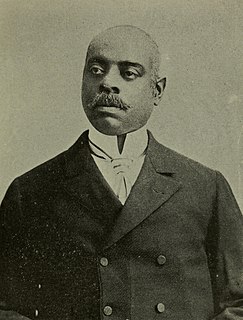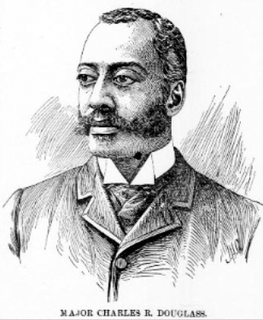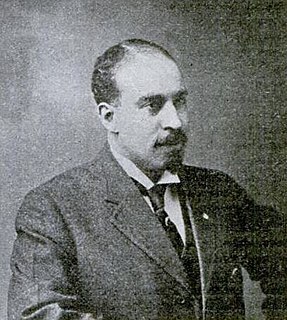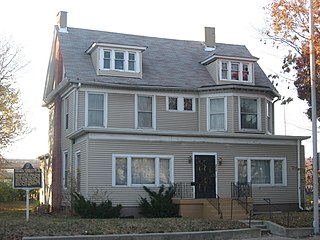Related Research Articles
William Henry Ferris was an author, minister, and scholar.

Mary Church Terrell was one of the first African-American women to earn a college degree, and became known as a national activist for civil rights and suffrage. She taught in the Latin Department at the M Street School —the first African American public high school in the nation—in Washington, DC. In 1895, she was the first African-American woman in the United States to be appointed to the school board of a major city, serving in the District of Columbia until 1906. Terrell was a charter member of the National Association for the Advancement of Colored People (1909) and the Colored Women's League of Washington (1892). She helped found the National Association of Colored Women (1896) and served as its first national president, and she was a founding member of the National Association of College Women (1923).

Otelia Cromwell was a distinguished scholar and Professor of English Language and Literature at Miner Teachers College. She was the first African American to graduate from Smith College, receiving a B.A. in Classics in 1900. She later earned her M.A. at Columbia University in 1910 and a Ph.D. in English at Yale University in 1926, becoming the first African-American woman to earn a doctorate degree there.

Louis George Gregory was a prominent American member of the Baháʼí Faith who was devoted to its expansion in the United States and elsewhere. He traveled especially in the South to spread the word about it. In 1922 he was the first African American elected to the nine-member National Spiritual Assembly of the United States and Canada. He was repeatedly re-elected to that position, leading a generation and more of followers. He also worked to prosyletize the faith to Central and South America.

William Calvin Chase was an American lawyer and newspaper editor. A native of Washington, D.C., he attended Howard University. As well as gaining admission to the bar, he edited the Washington Bee, a weekly newspaper, from 1882 until his death.

Charles Remond Douglass was the third and youngest son of Frederick Douglass and his first wife Anna Murray Douglass. He was the first African-American man to enlist in the military in New York during the Civil War, and served as one of the first African-American clerks in the Freedmen's Bureau in Washington, DC.

Harriet Gibbs Marshall was an American pianist, writer, and educator of music. She is best known for opening the Washington Conservatory of Music and School of Expression in 1903 in Washington, D.C.
Harrison J. Pinkett was a journalist and civil rights activist in Washington DC and then a lawyer in Omaha, Nebraska. As a journalist, he was the head of the so-called "Press Bureau" and often used the bureau's collective pen name, "P.S. Twister". In 1907, at the recommendation of friends in the NAACP, he moved to Omaha where he frequently worked in civil rights. He served as a first lieutenant in the 92nd Infantry Division in World War I and frequently defended the rights of black soldiers.

Lafayette M. Hershaw was a journalist, lawyer, and a clerk and law examiner for the General Land Office of the United States Department of the Interior. He was a key intellectual figure among African Americans in Atlanta in the 1880s and in Washington, D.C., from 1890 until his death. He was a leader of the intellectual social groups in the capital such as Bethel Literary and Historical Society and the Pen and Pencil Club. He was a strong supporter of W. E. B. Du Bois and was one of the thirteen organizers of the Niagara Movement, the forerunner to the NAACP. He was an officer of the D.C. Branch of the NAACP from its inception until 1928. He was also a founder of the Robert H. Terrell Law School and served as the school's president.
Walter J. Singleton was a journalist and civil servant in Omaha, Nebraska and Washington, D.C. He was an editor of the Omaha Progress and a member of the Afro-American League, a predecessor of the NAACP. In Washington D.C. he worked as a clerk for the Department of War and was active in a number of intellectual and social clubs.

Richard W. Thompson was a journalist and public servant in Indiana and Washington, D.C. He was at various times an editor or managing editor of the Indianapolis Leader, the Indianapolis World, the Indianapolis Freeman and the Washington D.C. Colored American. He was published as a general correspondent in The Colored American, The Washington Post, the Indianapolis Freeman, the Indianapolis World, Atlanta Age, Baltimore Afro-American Ledger, the Cincinnati Rostrum, the Charleston West Virginia Advocate, the Philadelphia Tribune and the Chicago Monitor. His longest-lasting relationship was with the Indianapolis Freeman. In 1896, the black paper, The Leavenworth Herald, edited by Blanche Ketene Bruce, called Thompson the "best newspaper correspondent on the colored press."

Robert Heberton Terrell was an attorney and the second African American to serve as a justice of the peace in Washington, DC. In 1911 he was appointed as a judge to the District of Columbia Municipal Court by President William Howard Taft; he was one of four African-American men appointed to high office and considered his "Black Cabinet". He was reappointed as judge under succeeding administrations, including that of Democrat Woodrow Wilson.

John Wesley Cromwell was a lawyer, teacher, civil servant, journalist, historian, and civil rights activist in Washington, DC. He was among the founders of the Bethel Literary and Historical Society and the American Negro Academy, both based in the capital. He worked for decades in administration of the US Post Office.

William J. Thompkins was a physician and health administrator in Kansas City, Missouri and served as Recorder of Deeds for the District of Columbia from 1934 to his death. He first received national notice when he challenged Jim Crow Laws in Oklahoma in Federal Courts in the early 1910s. He was a successful physician and was appointed superintendent of the Old General Hospital in Kansas City, Missouri and the Assistant Commissioner of Health in that City. He wrote an influential study of the relationship between housing conditions and tuberculosis in blacks and was active in Democratic politics which garnered him attention at the highest levels of the party. He became president of the National Negro Democratic Association and was a major campaigner for the Democratic Presidential Candidates in campaigns from 1928 until 1940, gaining national level party appointments in 1932, 1936, and 1940. In 1934 he was appointed Recorder of Deeds for Washington, DC. This position was the highest federal appointment given to an African American, a tradition which was started with Frederick Douglass' appointment to the position in 1881.

Freeman H. M. Murray was an intellectual, civil rights activist, and journalist in Washington D.C. and Alexandria, Virginia. He was active in promoting black home-ownership, opposing Jim Crow laws and lynching, and supporting positive representation of African Americans in public art. He was a founding member of the Niagara Movement and was an editor of its journal, the Horizon, along with W. E. B. Du Bois and Lafayette M. Hershaw. Alongside his other work, Murray was an important intellectual leader and wrote an influential book of art criticism. In this, Murray was one of the first historians of African American art. His work expressed a desire that art take seriously the representation of African Americans and that slavery not be overlooked in favor of representation of heroes and glory in public art.

Indiana State Federation of Colored Women's Clubs, also known as the Minor House, is a historic National Association of Colored Women's Clubs clubhouse in Indianapolis, Indiana. The two-and-one-half-story "T"-plan building was originally constructed in 1897 as a private dwelling for John and Sarah Minor; however, since 1927 it has served as the headquarters of the Indiana State Federation of Colored Women's Clubs, a nonprofit group of African American women. The Indiana federation was formally organized on April 27, 1904, in Indianapolis and incorporated in 1927. The group's Colonial Revival style frame building sits on a brick foundation and has a gable roof with hipped dormers. It was listed on the National Register of Historic Places in 1987.
The Robert H. Terrell Law School was a historically black law school in Washington, D.C., that offered evening classes from its founding in 1931 until 1950. It was founded by George A. Parker, Philip W. Thomas, Louis R. Mehlinger, Benjamin Gaskins, Chester Jarvis, and Lafayette M. Hershaw after Howard University ended its evening law school program. The school was named after Robert Heberton Terrell, a longtime African-American judge of the District of Columbia Municipal Court, who died in 1925.

Phyllis Terrell Langston was a suffragist and civil rights activist. She worked alongside her mother, Mary Church Terrell, in the National Association of Colored Women's Clubs and the White House pickets during demonstrations made by the National Woman's Party.
Israel Metropolitan Christian Methodist Episcopal Church is a Christian Methodist Episcopal Church in Washington, D.C. It was the first independent African American church of the city.
References
- 1 2 McHenry, Elizabeth (2002). Forgotten readers: recovering the lost history of African American literary societies . Duke University Press. pp. 141–185. ISBN 978-0-8223-2995-4.
- ↑ Moore, Jacqueline M. (10 February 2005). "Bethel Literary and Historical Association". Organizing Black America: An Encyclopedia of African American Associations. Vol. Online. Retrieved 4 March 2010.
- 1 2 3 Roberts, Kim (Spring 2010). "The Bethel Literary and Historical Society". Beltway Poetry Quarterly . 11 (2). Retrieved 4 March 2010.
- 1 2 3 4 5 6 7 8 9 10 "Observing Lincoln's Birthday". Evening Star (Washington (DC), District of Columbia). Tuesday, 11 February 1896, p. 12.
- ↑ "Equality under the Merit. System-the Interest of the Negro-American in Civil". Freeman (Indianapolis, Indiana). Saturday, 26 June 1897, volume: 9. issue: 26, p. 3.
- ↑ "Todyism". Saturday, 2 November 1895. Washington Bee (Washington (DC), District of Columbia). Volume: XIV Issue: 19, p. 4.
- ↑ "The Microcosm of the Negro". Friday, 22 January 1897. Evening Star (Washington (DC), District of Columbia), p. 10.
- ↑ Chesnutt, Charles Waddell; Crisler, Jesse S.; Leitz, Robert C.; McElrath, Joseph R. (2002). An exemplary citizen: letters of Charles W. Chesnutt. Stanford University Press. p. 8. ISBN 978-0-8047-4508-6.
- ↑ "Founder's Day at Bethel". Colored American (Washington (DC), District of Columbia). Saturday, 11 March 1899. Volume: 6. Issue: 49, p. 5.
- ↑ "Bethel Literary Association". Colored American (Washington (DC), District of Columbia). Saturday, 9 November 1901. Volume: IX Issue: 32.
- 1 2 "The Colored American is Thankful". Colored American (Washington (DC), District of Columbia). Saturday, 28 November 1903. Volume: X Issue: 21, p. 4.
- ↑ "Bethel Society Incorporated". Evening Star (Washington (DC), District of Columbia). Thursday, 31 May 1906, p. 16.
- ↑ "Bethel Literary". Washington Bee (Washington (DC), District of Columbia). Volume: XXVI. Issue: 34. Saturday, 19 January 1907., p. 5.
- ↑ Thomas, Richard Walter (2006). Lights of the spirit: historical portraits of Black Bahá'ís in North America. US Baha'i Publishing Trust. pp. 32–33. ISBN 978-1-931847-26-1.
- ↑ "At the National Capital. Hampton Night Was the Stellar Event". Freeman (Indianapolis, Indiana) Saturday, 26 November 1910. Volume: XXIII Issue: 47, p. 1.